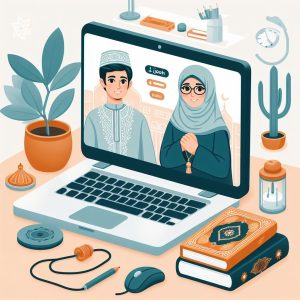In this blog post, we will explore how Madd Leen enhances your understanding and connection with the Quran, making it more accessible, relatable, and impactful than ever before.
Understanding and connecting with this divine book can sometimes feel like an uphill battle. That’s where Madd Leen comes in!
So, buckle up and get ready to embark on a transformative experience with the words of Allah!
Table of Contents
What is Madd Leen?
Madd Leen is a term used in Quranic recitation to describe the softening or mellowing of the sound of a specific letter, known as the letter Mad.
This softening effect is achieved by pronouncing the non-vowel letter Leen with a gentle and mellow voice pressure.
Al-Madd Al-Leen occurs when a waaw saakinah (وْ) or a yaa saakinah (يْ) are preceded by a letter marked with the fat-h diacritic (ــَـ).
The accomplishment of Madd Leen
To achieve the desired soft prolongation, the waw or yaa must be stretched instead of being read with a sukoon, which denotes a complete cessation of sound.
It is important to note that this easy prolongation of Al-Madd Al-Leen only occurs when the reciter intends to pause the recitation after the word containing the madd.
Understanding Madd Leen helps individuals reciting the Quran to pronounce it accurately and adhere to the rules of Tajweed.
By following these rules, reciters enhance their skills, maintain a proper flow, and preserve the rhythmic essence of the Quranic verses.
Importance of Madd Leen
Madd Leen holds great importance in the field of Tajweed. It is a fundamental aspect of Quranic recitation that helps us connect with and understand the Quran on a deeper level.
By mastering the correct pronunciation and rate of harakat, we can truly appreciate the beauty and eloquence of Allah’s words.
Madd Leen enhances recitation of the Quran by adding emotion and accuracy, and with practice, it becomes second nature.
Madd Leen Letters
Madd Leen refers to the softening of sound while stopping the recitation of a sentence that contains the non-vowel letters Madd Wau (وْ) and Ya’ (يْ), preceded by previous vowel letters.
The two letters of Leen (Wau sakinah preceded by fatha and Ya’ sakina preceded by fatha) originate from the Jawf (empty space in the mouth) when encountering Madd Leen.
Occurrence for Madd Leen
Madd Leen occurs when a word includes a letter of Leen and the reciter chooses to stop on it, resulting in a sukoon (non-vowel) placed on the last letter. In this case, the Madd is elongated or lengthened for 2, 4, or 6 counts.
The sign indicating the presence of Madd Leen is the requirement for the letters Waw and Ya’ to be marked with sukun and the preceding letter having a vowel fathah.
Madd Leen is only considered as Madd Leen if the recitation is halted on it. If the recitation continues, it remains as the letter Leen.
Pronunciation and Articulation of Madd Leen
The Waw (و) sound is produced by rounding the lips, while the Ya’ (ي) sound is created by raising the middle part of the tongue.
Understanding Madd Leen and Rate of Harakat
1. Understanding these aspects of Madd Leen and the rate of Harakat aids in accurately pronouncing and reciting the Quran.
2. Enriching the reciter’s ability to adhere to the rules and guidelines of Tajweed.
3. By incorporating these principles, reciters can effectively convey the proper flow and rhythm of the Quranic verses while maintaining the desired softening effect when pausing in their recitation.
The conditions for the occurrence of Madd Leen in Quranic recitation
1. Madd Leen is formed by the presence of the letters waaw saakinah (وْ) and yaa saakinah (يْ).
2. These letters must be preceded by a letter that carries the fat-ha vowel diacritic (ــَـ).
3. To properly pronounce Madd Leen, the reciter must pause or stop the recitation after uttering the word that contains the madd. It is important to note that if the recitation continues without a pause, the Madd Leen is considered void and does not apply.
By adhering to these conditions, reciters can ensure accurate and precise recitation of the Quran, adhering to the rules and guidelines of Tajweed.
Additional Notes on Madd Leen
We are delving deeper into exploring additional notes about Madd Leen that shed light on its significance and implications:
1. Madd Leen and Madd ‘Aridh:
Madd Leen is considered a subset of Madd ‘Aridh, and therefore, the elongation patterns for both are the same. This means that Madd Lin should be recited with 2, 4, or 6 harakat (vowel marks) on the side of expert reciters (Qurra’).
2. Involvement of Letters:
Madd Leen specifically involves the letters Madd Wau (وْ) and Ya’ (يْ), while the Alif letters are not involved in this particular madd.
3. Reader’s Choice:
Readers have the flexibility to choose whether to pause or stop their reading at the rate of 2, 4, or 6 harakat.
It is important to note that regardless of the chosen elongation, the recitation should maintain a soft and mellow tone, avoiding a harsh or forceful delivery.
A Note for Knowledgeable Readers in Tajweed
Madd Leen is derived from Madd ‘Aarid Lil Sukoon. When deciding to stop after a word, the ‘Aarid Madd is sounded. The same principle applies to Madd Leen, but it has been identified as a distinct tajweed rule due to its special case.
Madd ‘Iwad and Madd Leen
Unlike Madd ‘Iwad, Madd Leen becomes void if there is no intention to stop at the end of the word.
For example, in the phrase (ٱلْبَيْتَ مَثَابَةًۭ) “Al-bayta mathaabatan,” the conditions of Madd Leen are met as the letter “yaa” is preceded by a fat-ha.
However, since we continue onto the next word, “mathaabatan,” we do not elongate the “yaa” for 2, 4, or 6 counts. Situations like these render Madd Leen completely void.
By considering these additional notes, reciters can further refine their recitation skills, ensuring accuracy and adherence to the rules of Tajweed.
Examples of Madd Leen in the Quran
Several examples of Madd Leen can be found in the Quran, demonstrating the application of this rule in various words:
1. القَوْم (Al-Qawm):
In this word, the letter Wau (وْ) is preceded by a letter with a fat-ha, which satisfies the condition for Madd Leen. This results in the elongation and softening of the letter “wau” when recited, enhancing the flow and rhythm of the word.
2. الخَوْف (Al-Khawf):
Madd Leen is also evident in this word, where the letter Wau (وْ) follows a letter with a fat-ha. As a result, the pronunciation of the “wau” in “khawf” is elongated softly, contributing to the overall beauty and coherence of the recitation.
3. نَوْم (Nom):
Another example of Madd Leen can be seen in the word “nom,” where the letter Wau (وْ) is preceded by a letter carrying a fat-ha. By applying Madd Leen, the reciter elongates the sound of the “wau,” making it mellow and creating a harmonious flow within the verse.
4. البَيْت (Al-Bayt):
The word “bayt” exemplifies Madd Leen since the letter Ya’ (يْ) is preceded by a letter marked with a fat-ha. By adhering to the rule, the reciter prolongs the sound of the “ya’,” adding a gentle and mellow tone to the pronunciation, thereby enhancing the recitation.
These examples highlight the practical application of Madd Leen in the Quran, showcasing how this rule contributes to the accurate pronunciation and rhythmic delivery of specific words.
Techniques to Improve Madd Leen
Improving your understanding and application of Madd Leen in Tajweed can greatly enhance your Quran recitation. Here are some techniques to help you improve:
1. Practice Pronunciation:
Paying attention to the correct pronunciation of Arabic letters is crucial in mastering Madd Leen. Take time to practice pronouncing each letter accurately, focusing on the lengthening sound required for Madd.
2. Listen and Mimic:
One effective way to improve your Madd Leen is by listening attentively to experienced reciters who have mastered it. Try mimicking their pronunciation, rhythm, and flow as closely as possible. This will help you internalize the correct use of Madd Leen.
3. Study with a Teacher:
Enrolling in a Tajweed course at BayanalQuran or studying with a qualified teacher can provide valuable guidance and feedback on improving your Madd Leen skills. A knowledgeable instructor can identify any mistakes or areas that need improvement, allowing you to progress more effectively.
4. Recite Regularly:
Consistent practice is key when it comes to mastering any aspect of Tajweed, including Madd Leen. Set aside dedicated time each day for Quran recitation, ensuring that you incorporate proper application of Madd where applicable.
Benefits of Enhancing Madd Leen
Enhancing your understanding and connection with the Quran through the implementation of Tajweed rules, such as Madd Leen, can bring about numerous benefits. Let’s explore some of them below:
1. Improved Pronunciation:
One of the key advantages of mastering Madd Leen is that it helps you pronounce words correctly. By elongating certain vowels in specific positions, you develop a more accurate pronunciation, enabling you to recite the Quran with greater clarity and precision.
2. Enhanced Comprehension:
When you apply Madd Leen effectively, it enhances your ability to comprehend the meaning behind the verses of the Holy Quran. The elongation of certain syllables allows for a deeper understanding by emphasizing crucial points or concepts within a sentence or phrase.
3. Increased Focus:
Reciting with proper Tajweed encourages mindfulness and focus during your recitation sessions. Paying attention to details like Madd Leen requires concentration and attentiveness, which not only improves your overall reading skills but also helps in building a stronger connection with what you are reciting.
4. Spiritual Connection:
As Muslims, our goal is to establish a strong spiritual bond with Allah (SWT) through His divine words in the Quran. Enhancing Madd Leen aids in creating a harmonious rhythm while reciting verses from the Book of Allah, allowing us to experience a deeper sense of tranquility and spirituality during our worship.
Incorporating these techniques into your practice will undoubtedly elevate your relationship with both the Quran itself and its teachings. So why not embark on this journey towards improving your Tajweed skills today?
Begin your journey towards improving your Tajweed skills today with BayanalQuran’s Online Tajweed classes
Improve your Tajweed skills with BayanalQuran’s Online Tajweed classes. Learn and implement the rules of Madd Leen to enhance your recitation and connection with the Quran.
Experienced teachers, comprehensive curriculum, and personalized learning for all levels. Don’t miss out on this opportunity to improve your reading, reciting, and understanding of the divine words of Allah SWT. Enroll today!
FAQs
How do I pronounce Madd Leen accurately?
Pronouncing Madd Leen correctly requires practice and guidance from a qualified teacher or through online Tajweed classes like those offered by BayanalQuran. By learning the correct placement of harakat (vowel sounds) and understanding their rates, you can master this essential aspect of Tajweed.
Is it necessary to know Tajweed to recite the Quran?
While it is not necessary to know Tajweed to recite the Quran, it is highly recommended for proper recitation. Learning Tajweed helps improve pronunciation, intonation, and understanding of the Quranic verses, making the recitation more meaningful and impactful.
Conclusion
Understanding and mastering the concept of Madd Leen is crucial for anyone seeking to deepen their connection with the Quran.
By pronouncing the Madd Leen correctly and adhering to its rules, we can recite the words of Allah with precision and beauty. This not only enhances our Tajweed skills but also allows us to experience a profound sense of spirituality while engaging with the divine text.
Whether you are a beginner or an advanced learner, BayanalQuran’s Online Tajweed classes offer a comprehensive platform to improve your understanding and application of Madd Leen, as well as other aspects of proper Quranic recitation.
Begin your journey towards attaining excellence in Tajweed today and embark on a transformative path that will enable you to connect deeply with the words of Allah.















